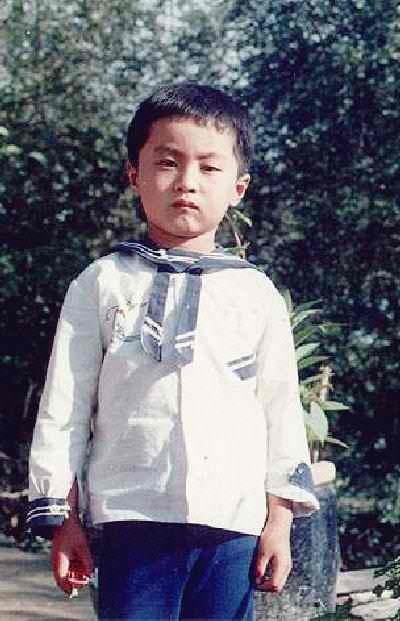
Chinese Boys' Garments

Figure 1.--A Chinese reader has provided this image of himself in 1989 at age 4 years old. He explains that sailor suits became common for boys after the Cultural Revolution and China began opening to the West during the 1980s. Image courtesy of Wang Chen.
|
|
Chinese boys have worn a wide range of garments. We know realtively little about the traditional clothing worn through the 19th and early 20th century and to what extent there were specific garments worn by boys. Western clothing began appearing in China during the 19th century, but was not extensivedly worn. Western clothing appeared in the major cities during the Republic which was created (1911). Consideration of fashion declined after the Japanese invasion (1937) and subsequent War. When the Chinese Communists emerged victorious in the Civil War (1949), they imposed fashion persprctions and guidelines much like earlier imperial regimes. Only since the 1990s have the Chinese been free to select the kinds of garments they wished to wear on an individual basis. Most young Chinese have chosen Western styled garments. American styles are particularly popular. Thus Chinese children for the first time are wearing garments much like those worn in the West.
We know realtively little about Chinese traditional clothing worn through the 19th and early-20th century and to what extent there were specific garments worn by boys. The subject is complicated bvecause China is a large, diverse country composed of several different regions and many minority groups, although Chinese polivcy, especially Communist policy is to enforce the standards and beliefs of the Han majority. This has included fashion. A student in Shanghai has provided us some informational on traditional clothing. Boys commonly wore Changshan (some people think that is same as Qipao, which is wrong), especially before 1911. After the Chinese Communist victory in 1949 these garments were no longer worn. It was like a dress with long sleeves, high collar (also call the mandarin collar), and often a vest on the outside. The buttons for boys are always on the left side, from the neck to left arm (under). For girls the buttons were always on the right side. Adults wore this garment as well.
Modern Garments
Headwear
Suits
Sailor Suits
Sailor suits were worn by a small number of middle class boys in Chinese cities during the early 20th century. This ended with the 1937 Japanese invasion and occupation of most of China's larger cities. With the victory of the Communists in 1949 the sailor suit was no longer seen in China as it was not in keeping with the drab, plain outfits that the Gvernment proscribed for children. Neither boys or girls wore sailor suits. Here the fact that the sailor suit was widely worn by Japanese school girls may have descredited the style even more in offical minds. Not until the end of the Cultural Revolution (1966-76) did children's fashions begin to become more varied. The first changes were in clothes for younger children, especially pre-school children. Thus by the later 1980s you begin to see mothers dressing younger boys in sailor suits.
Coats
Shirts
Pants
Hosiery
Footwear
Sources
Wang Cheng, e-Mail, August 29, 2002.

Related Chronolgy Pages in the Boys' Historical Web Site
[The 1880s]
[The 1890s]
[The 1900s]
[The 1910s]
[The 1920s]
[The 1930s]
[The 1940s]
[The 1930s]
[The 1940s]
[The 1950s]
[The 1960s]
[The 1970s]
[The 1980s]
Related Style Pages in the Boys' Historical Web Site
[Long pants suits]
[Knicker suits]
[Short pants suits]
[Socks]
[Eton suits]
[Jacket and trousers]
[Blazer]
[School sandals]
[School smocks]
[Sailor suits]
[Pinafores]
[Long stockings]
Navigate the Boys' Historical Clothing Web Page
[Return to the Main Chinese country page]
[About Us]
[Introduction]
[Activities]
[Biographies]
[Chronology]
[Clothing styles]
[Countries]
[Bibliographies]
[Contributions]
[FAQs]
[Glossaries]
[Images]
[Links]
[Registration]
[Tools]
[Boys' Clothing Home]
Created: August 30, 2002
Last updated: 8:21 PM 9/26/2018



